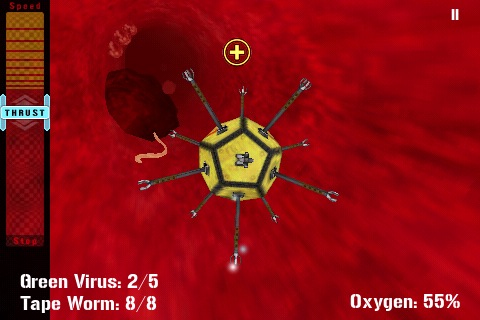
Did you know that if all of the veins in your body were placed end to end, the resultant string of gory, dripping tissue would be almost five thousand miles long?
It's a rather pointless fact, because the actual process of extracting your veins in this manner would be excruciatingly painful and lead to certain death, but even this unpleasant end seems preferable to spending a moment with the lamentable Dr. Nano.
The game showcases a plot that is eerily similar to that of the 1987 movie Innerspace, having you assume the role of a doctor who selflessly shrinks himself in order to enter the bodies of his patients and seek out the issues that are making them feel under the weather.
These aliments have a wide range of causes, including parasites, plaque, blood clots and viruses - all of which are dispatched by blasting them with a laser attached to Dr. Nano’s rather ugly Foglet Submarine.
Each mission requires the good doctor to eradicate a certain number of these irksome interlopers, but this isn’t your only concern: our puny physician requires a constant supply of oxygen. This means collecting the numerous red blood cells that float benignly within each patient’s body.
Occasionally, you step outside of the submarine and participate in Speed Run levels, where the objective is to pass through checkpoints as rapidly as possible. During these rounds you can pick up speed buoys which give you a much needed boost.
While Dr. Nano sounds like a rip-roaring trek through the human body, the reality is more akin to an internal cavity inspection sans lubrication.
For starters, the much-hyped 3D visuals are only likely to impress someone who still regards the original 32-bit Sony PlayStation as the pinnacle of graphical excellence. Simply put, they’re atrocious, with bland levels, laughably basic enemies and a shambling lead character who looks like he was designed by a pre-schooler.
It would be easy to forgive the aesthetic shortcomings if the gameplay was up to scratch, but sadly this aspect of Dr. Nano shares a comparable degree of ineptitude. Firstly, the collision detection is frustratingly inconsistent: collecting red blood cells is a hit-and-miss affair thanks to their small size, though hitting large blood clots with your sub’s laser is equally tricky.
Such issues are exacerbated by the choppy framerate and stuttering controls. When the screen becomes crowded with objects, just changing direction results in the game dropping to a crawl. As such, your frantic tilting isn’t reflected in real-time and results in a frustrating sense of confusion.
These problems mean that even if Dr. Nano were any fun to play, it would be difficult to extract any enjoyment from it. Fittingly, though, the game is anything but entertaining - the gameplay is tortuously repetitive, requiring no more than for you to point your crosshair at passing objects and press fire. There are 21 levels included with this version, each one as mind-numbingly dull as the last.
The developer is promising all kinds of enhancements for future updates - including bigger levels and more skills for Dr Nano to master - but the problems afflicting this sorry piece of software are so serious that it would take major surgery to rectify them.
Dr. Nano: The Doctor is Inside Review

